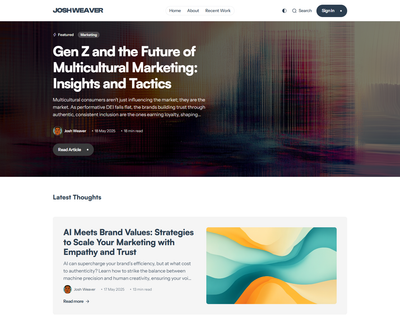How to Harness Brand Research to Supercharge Creative and Media Success
Brand research isn’t just about what people think—it’s about why they feel. This piece unpacks how mission-driven teams can use insight to shape culture, sharpen campaigns, and build trust across creative, media, and messaging.

Unlocking the full potential of your brand requires more than just intuition—it demands the strategic application of brand research. This powerful tool, when wielded with precision and empathy, can transform your creative and media strategies, propelling your brand to new heights. As marketers, we know the importance of cultural nuance and trust, especially when engaging with diverse or marginalized audiences. Drawing from high-impact campaigns like The Trevor Project and the Ad Council’s American Dream initiative, we see how deep key elements of brand research aligns us with not just our consumers’ minds, but their spirits too.
Brand research is not merely about gathering data; it’s about creating authentic connections. By centering on emotional resonance and public perception metrics, we can foster impactful messaging even in politically charged climates. This article takes you through a dynamic journey—crafting storytelling arcs and redefining relevance, differentiation, and sustainability within the marketing landscape. From identifying your audience's lived contexts beyond demographics to adapting your strategies post-launch, we’ll explore each stage with context-driven insights.
Navigating today’s complex marketing terrain requires agility and insight-driven execution. Through competitor analysis, creative storytelling, and strategic media planning, we'll examine how to integrate brand research seamlessly into every action—from ideation to execution. Join us in an exploration that champions inclusivity, shared purpose, and transformative insight, aiming to guide mission-driven organizations toward meaningful engagement and sustained success.
Understanding Brand Research
In the landscape of mission-driven marketing, brand research goes beyond mere data collection—it's a comprehensive trust exercise that illuminates the pathway to authentic storytelling and strategic clarity. Think of it as an immersive, cultural exploration rather than a detached academic exercise. My experience leading four-phase research at The Trevor Project demonstrated this: it's about deeply understanding the fabric of your brand and audience, particularly when engaging communities marked by complexity and nuance. Brand research helps organizations peel back the layers to reveal true alignment, ensuring that every message resonates with the intended audience and community, fostering a connection steeped in trust and cultural sensitivity.
Importance of Brand Research
Brand research serves as the backbone for building meaningful connections, especially when both trust and social impact are pivotal to success. For example, during constrained political climates, the Ad Council’s American Dreams campaign relied on brand research to refine its messaging. By anchoring our approach in public perception metrics and gauging emotional resonance, we fashioned a narrative that transcended obstacles, fostering inclusion and understanding. This strategic foresight ensures your brand’s story aligns with its audience's evolving values, bolstering both relevance and credibility against a backdrop of shifting societal tides.
Inclusive marketing isn’t just a moral imperative—it’s a strategic one. As outlined in Boston University’s Business Review, brands that prioritize accessibility and cultural intelligence are far more likely to build trust and long-term loyalty. During the development of the American Dreams campaign, we leaned on this principle—grounding our work in community-specific insights that shaped how inclusion was expressed across mediums. It’s a reminder that relevance today means more than recognition; it means resonance.
Key Elements of Brand Research
Brand research centers around three pivotal pillars: Relevance, Differentiation, and Sustainability. Each element guides strategic choices and sharpens brand positioning.
Relevance: At the Ad Council, relevance was redefined to embrace the fluidity of LGBTQ+ identities, bridging generational perspectives. This dynamic understanding empowered campaigns to speak authentically to diverse experiences, ensuring messages aren't just heard but felt.
Differentiation: A brand’s unique value proposition distinguishes it within a crowded marketplace. By discerning your brand's distinct traits, you create a memorable identity offering that’s discernibly yours alone, as demonstrated in the bold reimagining of The Trevor Project's identity.
Sustainability: Beyond environmental stewardship, true sustainability encompasses emotional and reputational longevity. This holistic approach ensures that your brand endures as a beacon of reliability and trustworthiness, much like how meaningful equity-driven narratives must withstand cultural evolutions.
By delving into these components, you lay a robust foundation upon which a resilient and resonant brand thrives—an endeavor that aligns your mission with market realities and societal expectations.

Conducting Market Research
Conducting market research is a cornerstone of effective brand strategy, transforming abstract ideas into actionable insights. This process explores everything from consumer behaviors to market dynamics, equipping brands with the tools needed to navigate competitive landscapes with precision. It is not just about collecting data but about uncovering the deeper narratives that shape how brands engage with their audiences. By understanding industry trends and spotting market opportunities, businesses can fine-tune their differentiators and better position themselves to meet the needs of their ideal customers. This informed approach prevents uninformed decision-making and ensures that each strategic move resonates with the broader market landscape.
Identifying Target Audience
Identifying a target audience is essential for crafting impactful marketing strategies. It's about understanding who your message needs to reach and tailoring your communication to resonate deeply with them. This goes beyond demographics; it involves delving into psychographics to comprehend lifestyles, values, and needs. For example, tailoring campaigns for Gen Z LGBTQ+ youth, as done at The Trevor Project, involves an appreciation of their unique cultural contexts and media habits. Understanding these nuances ensures that marketing efforts are focused, minimizing wasted resources and maximizing ROI. By aligning your message and medium to your audience's preferences, you enhance both their experience and your campaign's effectiveness.
Today, Gen Z isn't just ad-averse—they're actively blocking and skipping traditional formats. According to Adweek, 99% of Gen Z skips ads and 63% use ad blockers. This behavioral reality demands non-intrusive, story-driven approaches that respect attention rather than hijack it.
Consumer Behavior Insights
Gaining insights into consumer behavior is like finding the map for your marketing journey. It's about translating audience signals—such as online reviews and social media interactions—into strategies that resonate. At places like the Ad Council, these insights were pivotal in molding the Love Has No Labels campaign, testing media strategies to bridge behavior and belief. Understanding brand perception and aligning communication strategies accordingly ensures that marketing efforts reflect actual consumer desires. Moreover, these insights are crucial in developing pricing and product strategies that reflect what consumers value. Ultimately, the ability to read this map accurately determines whether campaigns connect authentically or fall flat.
Understanding Gen Z’s platform habits is non-negotiable for modern media planning. A Pew Research Center report shows that over 90% of teens use YouTube, while TikTok engagement is highest among Black and Hispanic youth—many of whom are “almost constantly” active. These insights are essential for equitable audience reach.
Understanding consumer behavior means reading beyond the metrics—it’s about emotional fluency. According to Forbes, emotional branding can deepen consumer connection, particularly when values are aligned. This aligns with our approach at the Ad Council, where we moved beyond transactional messaging and centered emotional drivers like belonging and empathy. Emotional branding isn’t fluff—it’s fuel for behavior change.
Preferences and Expectations
Consumer preferences and expectations are the pulse of any brand's market presence. Recognizing invisible expectations, like the demand for inclusive language or specific visual representations, can significantly sway campaign outcomes. Such expectations might not feature in straightforward surveys, yet they are pivotal for fostering meaningful connections.
Inclusive marketing must account for invisible expectations—those unspoken, identity-rooted cues that shape whether someone feels seen. In their 2024 guide to inclusive marketing, Penfriend.ai details how brands can embed inclusivity at the core of strategy—from imagery to copy, from UX to tone. This level of intentionality is what turns passive engagement into active affinity. It’s not just about marketing to diverse audiences—it’s about marketing with them in mind.
Brands must actively listen to perceptions and feedback to refine their offerings, ensuring they align with evolving audience standards and budgeting behaviors. When brands meet these nuanced expectations—be it through sustainable practices or personalized customer service—they not only enhance their market alignment but also foster enduring loyalty.
The emotional undercurrents of marketing have been rigorously studied—and the data backs up the instinct. In a recent research paper on emotional marketing, researchers found that campaigns engaging with core emotional motivators were significantly more effective in influencing consumer behavior. This academic lens reinforces what we observed firsthand in the Love Has No Labels campaign: when you meet people where they feel, you move them further than logic ever could.

Competitor Analysis
In the world of mission-driven marketing, competitor analysis is more than a tactical move—it's a strategic imperative and a competitive advantage Think of it as mapping out the narrative landscape rather than just plotting market players. This approach involves a nuanced understanding of how competitors interact with audiences and the subtler forces—such as cultural trends or policy changes—that shape this engagement. By analyzing competitors’ strengths and weaknesses, you can identify opportunities to establish or reinforce your brand’s unique market position. This exercise isn't just about charting where competitors succeed; it's about uncovering their shortcomings and spotting those elusive white spaces ripe for your brand's impactful narrative. Successful competitor analysis will pinpoint your market position and highlight potential alliances or competing ideologies, empowering you to craft responsive, proactive strategies.
Analyzing Competitor Strategies
Delving into competitor strategies isn't about imitation—it's about distinction. When you examine their offerings, customer interactions, and even pricing tactics, a story unfolds. This is a story of how others succeed or where they fall short, spotlighting areas for your differentiation. For instance, by scrutinizing how a competitor engages with your mutual audience—be it through sophisticated AR marketing or grassroots community initiatives—you'll unearth insights into their brand identity and value propositions. Direct observation, such as downloading competitor apps or engaging with their content on social platforms, can yield practical understanding. This hands-on approach ensures you gather both qualitative and quantitative insights, providing a panoramic view of the competitive landscape. These insights inform your creative and media approach, adding texture and context to your brand's narrative.
Understanding Market Positioning
Defining your brand’s market position involves articulating its essence in contrast to the competition. This isn't a mere exercise in crafting a pithy positioning statement; it’s about honing in on your unique value propositions. A robust market positioning helps your brand rise above the noise in a marketplace where consumer loyalty is increasingly fragile. By deeply understanding competitor interactions with their market, from their strategic partnerships to customer feedback loops, you can better sculpt your brand’s narrative. Analyzing online reviews and social media chatter, for example, can reveal where competitors excel and where they falter. These insights are integral to shaping a positioning that not only distinguishes your brand but resonates with the values and needs of your target audience, ensuring your message remains relevant and impactful.

Developing Creative Strategy
In the competitive landscape of today’s mission-driven organizations, a well-defined creative strategy acts as the cornerstone of effective brand communication. This isn’t merely about meeting strategic goals; it’s about cultivating an authentic brand identity that resonates with audiences on multiple levels. By synthesizing creative development with market research, brands not only differentiating and effective brand strategy but align their storytelling, tone, and visual identity with the nuanced expectations of their ideal customers. The creativity lies not just in artistic vision, but in how that vision seamlessly integrates with broader brand strategies to forge lasting connections and drive growth.
Puma’s “Go Wild” campaign offers a compelling case study in Gen Z engagement. As detailed in Adweek, the brand centered its message around social connection and immersive experiences—two elements Gen Z actively seeks in both sport and brand relationships.
Crafting Brand Stories
Crafting a compelling brand story involves creating a narrative that brings a brand’s personality and mission to life, ultimately establishing a profound emotional connection with the audience. Imagine the brand as a protagonist in its own story, confronting and overcoming barriers faced by its community. This isn’t just storytelling; it’s a strategic act of empathy and resolve. As demonstrated in the American Dreams campaign, crafting relatable brand stories moved beyond static language, employing lived experiences to invite audiences to feel, think, and act. A consistent message across all touchpoints ensures this alignment not only remains but thrives, prompting potential customers to see themselves in the brand’s narrative and inviting meaningful engagement.
Values alignment isn’t a “nice to have”—it’s a baseline expectation. Deloitte reports that Gen Z places heavy emphasis on social activism, sustainability, and justice, while also being less loyal to brands unless authenticity is clearly demonstrated. They want brands to act, not just speak.
Defining Brand Voice and Tone
Your brand’s voice is the heartbeat of your identity—it’s the consistent personality echoing across all communications. The finesse lies in tone, which fluctuates to match each unique context—lighthearted in social media, weighty and earnest in crisis communications. By weaving together humor, care, empowerment, and pride—as seen with The Trevor Project—brands can deftly navigate varied political landscapes while preserving authenticity. This not only builds trust but also establishes a recognized and reliable communication style. Understanding when and where to flex in tone without losing the core voice is central to cultivating emotional connections with diverse audiences, instilling a sense of familiarity and reliability.
Effective creative strategy isn’t just about originality—it’s about fidelity to audience truth. Take Louis Vuitton’s recent content strategy, for example. Their success hinged not just on aesthetics but on deep audience alignment and thoughtful platform use. It’s a powerful illustration of how legacy brands can evolve creatively without sacrificing consistency—a lesson just as applicable to mission-driven orgs seeking both breakthrough and brand clarity.
Establishing Visual Identity
Visual identity is the face of your brand’s narrative, turning abstract ideas into tangible expressions. It’s about more than color palettes or typography; it’s about crafting a cohesive visual story that aligns with your brand’s messaging and values. Consistency across design elements—whether on a digital platform or physical campaign—reinforces recognition and cultivates trust among audiences. As a brand's visual language evolves to reflect its cultural and ethical values, every logo, color scheme, and design choice communicates its identity. As your constructive storyteller, the visual identity underpins all marketing efforts, ensuring the aesthetics resonate across various channels and with diverse audience segments, thus solidifying brand prominence and equity in the marketplace.
Bubble Skincare is winning with Gen Z and Gen Alpha by showing up as a transparent, inclusive “older sibling” figure. Adweek notes the brand’s core values of community, cruelty-free practices, and real guidance has earned both trust and spending power from younger consumers.

Formulating Media Strategy
Crafting an impactful media strategy is akin to orchestrating a symphony; each component must harmoniously work together to create a compelling crescendo that reaches, resonates, and converts audiences. Within this landscape, strategic foresight plays a pivotal role. Tools like Marketing Evolution’s Scenario Planner have revolutionized the way organizations adaptively optimize their media mixes without disrupting ongoing campaigns. This approach allows brands to project future scenarios, assess potential outcomes, and strategically refine their actions. By running "what if" scenarios, brands enhance their media planning, reducing ad waste and ensuring the seamless alignment of campaign objectives. Ultimately, building a media strategy that navigates the ever-shifting currents of market trends and consumer behaviors is an exercise in adaptive precision—especially in mission-driven settings where impact, rather than mere exposure, remains the North Star.
Media Planning Essentials
Media planning acts as the structural backbone of any robust marketing initiative, ensuring that messages not only reach their intended audiences but land at the moments when they’ll matter most. This requires a strategic orchestration of content types—from blog posts that deepen narrative and boost SEO, to targeted advertising campaigns that drive awareness, to social media activations that spark real-time engagement. The process involves the careful selection and scheduling of these channels to deliver messaging that’s coherent, platform-native, and culturally responsive.
Continuous tracking and analysis are essential; by monitoring performance across formats and funnels, marketers can recalibrate their mix and sharpen their focus on high-performing assets. An integrated media strategy doesn’t just coordinate—it compounds—building momentum across platforms to create a unified brand experience. With real-time insights guiding creative and spend, brands can fluidly optimize their approach, blending storytelling with strategic execution to drive measurable and lasting ROI.
Budget Allocation and Tracking
In the world of media strategy, a flexible budgeting approach is integral to success. Instead of locking resources into rigid channels, organizations benefit from nimble adjustments as campaigns unfold, allowing them to capitalize on emergent opportunities or pivot in response to unexpected challenges. Regular budget tracking is essential—it’s a diagnostic tool that reveals which tactics yield results and which require recalibration. This dynamic monitoring also responds to shifts in the external market, ensuring campaigns remain relevant and impactful. Strategically timing advertising activities to align with budget distribution can amplify impact, and continual revision of budgetary plans ensures that operations are both efficient and aligned with overarching marketing objectives. By maintaining this flexible, responsive approach to budgeting, brands are equipped to maximize ROI and achieve their benchmarks, driving both immediate results and long-term success.
Audience Segmentation Techniques
Audience segmentation is not merely the act of dividing consumers into manageable groups; it is about unveiling the intricacies that define how brands resonate on a personal level. Employing the STP framework—segmentation, targeting, and positioning—marketers can craft strategies that echo the true voice of their potential customers. Demographic information forms the basis, yet it is the fusion with person-level data that enriches this picture, allowing for a nuanced segmentation that speaks to behaviors and preferences. This tailored approach in messaging and channel selection elevates communication to an art form, where each piece of content finds its ideal audience. By analyzing engagement analytics, marketers can further refine these segments, pinpointing which demographics and psychographics interact with specific types of content. Segmentation is thus an ongoing dialogue between brand and audience—one that fosters true connection and enduring loyalty.
Reaching Gen Z requires relevance, not repackaging. Google urges brands to “meet Gen Z in their world,” emphasizing authenticity and platform-native creative over traditional tactics. YouTube Shorts, with 1.5 billion monthly users, exemplifies how short-form video has become a core Gen Z format.
Implementing and Optimizing Strategies
An agile approach to a cohesive strategy implementation is essential in today's fast-paced marketing landscape. With consumer behaviors shifting rapidly, due in part to technological advancements and evolving societal norms, maintaining an adaptive framework ensures that your media strategy remains relevant and effective. The key lies in aligning marketing efforts with broader business goals while leveraging insightful market research to inform decision-making. This approach not only allows for the refinement of tactics based on quantifiable metrics but also supports a seamless transition from traditional methods to innovative solutions that resonate with target audiences. Regular evaluation and adaptation of strategies will bolster competitive differentiation and a stronger brand identity in an ever-changing marketplace.
Monitoring Performance Data
To stay ahead in marketing, measuring and analyzing performance data is crucial. Setting measurable objectives and identifying key performance indicators (KPIs) that align with overarching business goals are foundational steps in this process. By regularly tracking these KPIs, companies gain valuable insights into the effectiveness of their campaigns, allowing them to make informed decisions about optimizing future strategies. This data-driven approach not only helps businesses adapt to changing consumer behaviors but also ensures their marketing objectives remain relevant. Regularly reviewing KPIs offers the opportunity to reassess and refine marketing strategies, ensuring that efforts are aligned with evolving organizational goals and adjusting tactics as needed.
Adjusting Strategies Based on Feedback
Customer feedback is one of the most powerful tools available for refining brand strategies. By actively listening to social media discussions, online reviews, and direct customer interactions, businesses can gather invaluable insights into customer preferences and pain points. Platforms like Google, Yelp, and Trustpilot provide unfiltered feedback that can reveal patterns in customer sentiment, guiding necessary adjustments in strategy. Whether it's tweaking messaging, enhancing visuals, or adopting new technologies, responding to this feedback ensures strategies not only meet corporate KPIs but also resonate more deeply with the audience. Monitoring engagement rates and adapting strategies based on real-time customer interactions maintain a dynamic, responsive approach that equates to sustained competitive advantage.

Integrating Brand Research with Strategies
To captivate with a strong brand strategy, integrating brand research with strategies isn't just an option—it's a necessity. Comprehensive market research serves as the cornerstone for developing a brand strategy by identifying brand differentiators and pinpointing ideal customers. Without this foundational work, even the most creative campaigns risk faltering in their execution. The key lies in weaving insights gained from research into every strategic decision, ensuring that each move is not just informed, but primed for impact. The challenge, therefore, is making these insights a living, actionable tool rather than a static report gathering dust.
Aligning Research with Creative Efforts
Aligning research with creative efforts requires a structured approach that deep dives into consumer brand usage, attitudes, and prevailing market conditions. These insights are instrumental in crafting creative executions that resonate deeply with the target audience. Imagine the wealth of understanding gleaned from a thorough analysis of customer interactions across multiple channels—like the invaluable feedback found in customer support dialogues and online reviews. Such feedback is the gold standard for understanding customer preferences and serves as the bedrock for optimizing creative strategies.
This process isn't just about following trends, but utilizing trend analysis to anticipate market shifts and creatively capitalize on emerging opportunities. Successful creative development hinges on data-driven strategies rooted in thoroughly understanding your audience and the competitive landscape. Coupling creative testing with these insights ensures communication strategies hit their mark, maximizing advertising effectiveness and profitability.
Harmonizing Research with Media Plans
Media planning must transcend the traditional views of just placing ads; it should be viewed as crafting an ensemble performance where each media channel plays a unique yet harmonious role. This orchestration demands an in-depth understanding of market trends and the competitive landscape to discern what has worked for similar brands. With this knowledge, brands can reach new audiences effectively, enhancing awareness, consideration, and driving conversions.
Trend analysis becomes a pillar of this comprehensive brand strategy component by illuminating market dynamics and emerging opportunities. By honing in on these insights, brands can fine-tune their differentiators and refine their understanding of their ideal customers. This ensures their branding efforts remain impactful rather than becoming white noise in the marketplace. Strategic brand communication emerges not as a haphazard exercise, but as a deliberate analytical approach where social media announcements, paid ads, and creative efforts converge seamlessly. Through this method, brands reaffirm their identity while fostering lasting connections with their audience, proving that research and media plans, when harmonized, can indeed elevate brand strategy to new heights.
Regular Analysis and Refinement
In the ever-shifting landscape of marketing, regular analysis and refinement of your brand strategy isn’t just a task—it’s a strategic imperative. This ongoing process ensures that your marketing efforts resonate with current consumer preferences and align with market trends. The refinement journey is one of discovery and iteration, consistently testing different approaches to unveil those that truly connect with your target audience. By analyzing audience responses to your messaging, visuals, and technological interfaces periodically—preferably every few months—you can gauge the effectiveness of your strategies. This practice not only helps maintain a unique market position but also ensures your brand message remains dynamic and engaging. Such a thorough analysis can unearth disconnects between your brand and your audience, paving the way for strategic adjustments that elevate consumer engagement and loyalty.
Leveraging Performance Metrics
A strong media strategy hinges on the framework it provides for establishing clear objectives and tracking key performance indicators (KPIs). These metrics become your compass, guiding the ongoing optimization of your media mix, messaging, and tactics to ensure branding efforts hit their mark. By regularly reviewing progress against predefined KPIs, you can determine if your primary objectives are being met and identify areas requiring refinement. This might mean adjusting visual elements, exploring new technologies, or even recalibrating your messaging to better reverberate with your target customer. When a media strategy is meticulously aligned with broader business goals, it effectively marries advertising and marketing efforts to the achievement of overarching strategic objectives, reinforcing the impact of your initiatives.
Adapting to Evolving Market Trends
Market trends don’t just inform strategy—they reshape it. Understanding these dynamics through trend analysis, scrutinizing industry reports, and observing consumer behavior patterns, allows brands to pivot their strategies effectively. In today’s fast-paced digital landscape, ongoing monitoring, measuring, and optimization of your media strategies are necessary to remain in sync with shifting market conditions, consumer behaviors, and business objectives.
For instance, Gen Z’s identity is shaped by digital immersion and progressive values. As McKinsey describes, they’re “inclusive consumers” who demand authenticity, equity, and environmental action from the brands they support. With Gen Z making up 60% of TikTok’s users, digital platforms are not just a preference—they’re home turf.
By leveraging insights from digital marketing, you can pinpoint consumer preferences and emerging purchasing trends, ensuring your approach is both fresh and relevant. This requires continuous analysis of brand strategies, making intentional adjustments to align with the latest in customer preferences, technological advancements, and graphic design trends. Monitoring audience perceptions and assessing the target market’s evolution will highlight necessary pivots, keeping your strategic direction both agile and informed by nuanced trends.

Enhancing Brand Communication
In the ever-evolving landscape of marketing, enhancing brand communication is more than just promoting a product—it's about weaving a connective thread between the brand and its audience. A robust communication model does more than disseminate information; it crafts a narrative that invites customers to be part of the brand story, fostering loyalty and trust. Whether communicated through social media announcements, billboards, or TV commercials, effective brand communication aims to generate an emotional attachment that transforms passive consumers into passionate brand loyalists.
The key lies in aligning creative efforts with strategic insights to build trust and drive brand recognition. Utilizing brand research tools, marketers can evaluate how well their creative elements resonate on both emotional and rational levels, ensuring that every brand touchpoint maximizes advertising effectiveness. By committing to an analytical approach in all facets of communication, brands can strategically direct their messaging to cultivate a deeper connection with their audience, resulting in sustained engagement and brand advocacy.
Brand loyalty doesn’t start with a logo—it starts with psychology. As noted in Emporia State University’s analysis on branding psychology, emotional response is often the single most important predictor of brand preference and repeat behavior. That’s why mission-driven communication must center emotional intelligence just as much as performance metrics. The goal isn’t just to be understood—it’s to be felt.
Strategies for Effective Communication
Effective brand strategy doesn’t happen by chance; it’s meticulously crafted through strategic insight and market research. By deeply understanding market dynamics, audience preferences, and competitive pressures, brands can construct communication strategies that truly resonate. A comprehensive communication strategy builds on establishing strong visuals, defining distinct brand personas, and crafting messaging that highlights unique brand differentiators. These elements work in harmony to set the brand apart in a crowded landscape. Integration is key—coordinating marketing efforts across various channels ensures a consistent and engaging brand experience, crucial for maintaining audience trust and fostering long-term relationships. Strategic branding doesn’t just transmit a message; it invites engagement, fosters loyalty, and often cultivates word-of-mouth marketing—a testament to the power of a well-crafted strategy.
Beyond crafting the message, understanding the competitive landscape is vital. Market research informs not just what to communicate, but how and where to do so most effectively. For example, brands may recognize that traditional email campaigns are no longer sufficient and choose to shift resources to more effective native advertising. As markets change, so too must strategies; staying attuned to shifts allows for proactive realignment of media strategies. Ultimately, the combination of research, strategy, and execution forms the backbone of a successful brand communication approach, ensuring that brands don’t just speak, but are heard and embraced by their audience.






